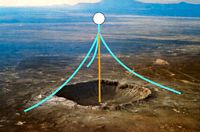 In my last post on this subject, I wrote about the changes that were being implemented for the upcoming Space Elevator Games. They are:
In my last post on this subject, I wrote about the changes that were being implemented for the upcoming Space Elevator Games. They are:
- The climb will now be one full kilometer (10 times what was required in the 2007 Games).
- There will now be two levels of prizes: $900,000 (for a climb averaging 2m/s and $1,100,000 for a climb averaging 5 m/s).
I also wrote about how a couple of laser-supply companies (TRUMPF and DILAS) are now working with Spaceward to help lower the costs of the lasers which will be necessary to power a climber a full kilometer up from the ground.
 In this post, I want to talk about the raceway itself. How do you build a one kilometer vertical raceway system, a system which will have to a) support the raceway itself, b) support the climber, c) be able to lower “stuck” climbers back to the ground and d) be undamaged by stray laser beams that may occur? And, once you have this raceway system, where do you put it?
In this post, I want to talk about the raceway itself. How do you build a one kilometer vertical raceway system, a system which will have to a) support the raceway itself, b) support the climber, c) be able to lower “stuck” climbers back to the ground and d) be undamaged by stray laser beams that may occur? And, once you have this raceway system, where do you put it?
The first part of this question, how do you build this raceway, has a tentative answer. Spaceward is aiming towards a balloon-supported system with a raceway made out of 3/16″ or 1/4″ twisted steel cable. As was all too obvious last year, Spaceward needed to find something much stronger than the ribbon they used in the previous two competitions (and which broke a couple of times last year). The steel cable is more than strong enough, but will require that the Climbers use a different mechanism to grip the raceway than they did before. The balloon would be tethered with (probably) three cables. The raceway cable itself would travel from a ground point (centered between the three tether cables) up to the balloon. Fears of the laser hitting the balloon and causing it to burst are unfounded because most of the time the wind will be blowing the balloon and moving it and, consequently, the cable system holding it up and the raceway itself. This will cause the raceway cable to droop some and so a laser aimed at a climber on the cable will not be pointed directly at the balloon. When the climber gets very close to the top, a small shield under the balloon can shield it. It may also turn out that the balloon itself is “invisible” to the lasers in the 800-1000 nm range, rendering the whole issue moot.
So, we have a tentative solution to building a one km raceway. Now, where do you put it? This becomes a very big system. The diameter of the circle created by the tethers is on the order of two-three kilometers; i.e. nearly two miles. To get an idea of how big that is, Spaceward has posted on their site (and also shown on this post) a picture of how big the raceway system would be in respect to Meteor Crater in Arizona (as an aside, wouldn’t that be the coolest place for a racecourse ever?). This is where we are now; Spaceward is actively looking for a site to hold the 2008 Competition. On their 2008 Competition web page, they list the following sites they are considering:
- Davis County Fairgrounds, UT (where the 2007 Games were held)
- Meteor Crater, AZ (pictured)
- Bonneville Salt Flats, UT
- Albuquerque Balloon Festival, NM
- White Sands, NM
- Rockets Sites:
Brothers Rocket Site, OR
Black Rock, NV
Jean Dry lake, NV
Mansfield, WA
Tripoli Idaho Swan Falls, ID - NASCAR raceways:
(must be away from airports!)
So, if you know of any sites that might satisfy the requirements (Sites must be able to accommodate a 1 km tall tethered balloon pyramid, offer convenient logistics support, and be relatively easily accessible. Natural landmarks get extra points.) please let Ben Shelef at Spaceward know! You can contact Ben via email at ben [at] spaceward [dot] org.

I would suggest to contact Liftport. They have the right experience in building tethered towers. You do not even need a pyramid structure. It is better to look for a location with very little wind.
LiftPort also has experience building “ribbons” from tethered balloons. For example, here is a photo and little info about how LiftPort made the climber ribbon for their 1 mile test.